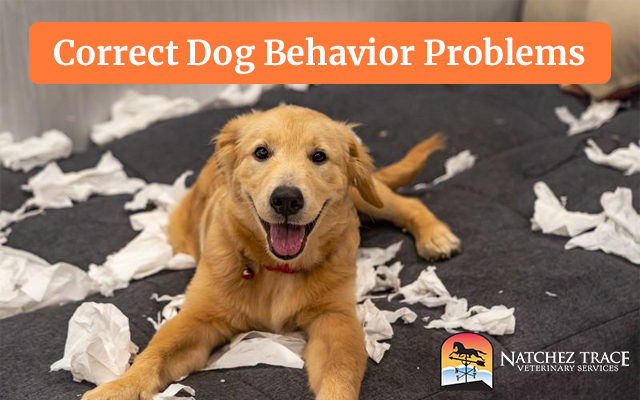Wondering How to Correct dog behavior problems?
Here are some thoughts, tips, and ideas that are sure to bring the lives of you and your dog into balance and harmony!
Be the Pack Leader
Even though dogs and people have lived together for thousands of years, evolution has not yet developed a complete instinctive understanding between man and man’s best friend. Sometimes living with pets can be as frustrating and confusing as living with other people!
The first thing to keep in mind when attempting to correct dog behavior problems is that dogs are pack animals.
Dogs are social. They like to interact with people and dogs. All dog packs have a leader that makes the decisions for the pack.
All of the other dogs are subordinate to the leader.
If your dog considers you to be the leader of his pack, he will be more than willing to do what you want.
Especially if it earns him praise or petting.
Make sure that your dog knows that you are the leader–you are the one who decides when to eat, when to go out, and when to play.
Your dog should never think he is the leader in your house.
Just like with children, dogs that have rules to follow and respect for their parents are well behaved.
Many behavior problems are a direct result of a lack of leadership on the part of the owner.
Another thing to keep in mind when working to correct dog behavior problems is that dogs are very sensitive to body language and visual cues.
One example is that talking face to face can be confrontational in a dog’s body language.
Standing side by side is not. Learn dog body language and nonverbal cues.
Learn how your dog reacts and use this nonverbal language to your advantage.
In the dog world, love is not related to social status.
Most dogs live in relaxed harmony when the social hierarchy is clear no matter where they stand.
Make sure not to cater to your dog, let your dog’s behavior drive your decisions on how to treat it.
Remember–you are the pack leader!
If your dog bites you, totally ignore it for two days to notify it there’s been a change in the household.
Don’t speak to it or look at it, even when feeding or letting it out.
Then follow this program to the letter for at least a month before giving any slack.
Applying “social distance” when your pet is misbehaving and rewarding with praise and attention only when it is good is the key to good behavior.
Remember to reward the behavior you want to see continued!
Training Strategies
Below are some training strategies to help you correct your dog’s behavior problems.
- Petting: Keep it brief and pet only for obedience. Reward obeying commands with attention. If your dog demands petting, either look away from it (fold arms, turn head up & away from the dog) or ask it to sit down and then pet when it obeys. If you want to pet your dog, call it to you, don’t go to it.
- Practice “Look Always”: Don’t let your dog demand play, food, or petting. If your dog gets pushy, simply cross your arms, turn your head upward and to the side looking away from the dog. If your dog counters by moving to your other side, turn your head the other way. This is good practice to do any time your dog approaches you if he is very dominant and pushy. It is especially important if your dog has been aggressive towards you.
- Teach “Lie Down and Stay.”A good solid “lie down and stay” is a tried-and-true obedience learning tool. It teaches your dog to be patient and to wait for your command. You can even practice while watching television or reading. Start with one-second stays for the first few days, and work up to longer and longer ones. After three weeks, most dogs can handle a half-hour down stay during a quiet time of the day. Correct breaks with a body block or a downward leash correction—not by simply repeating “down” & “stay” over and over again. If your dog gets up 25 times, then correct it 25 times with the same actions and tone of voice. Do not include anger in your correction. BE FIRM!
- “Wait At The Door”: The pack leader has priority. (Remember YOU are the pack leader!) Pack leaders get to push out the door first to get something they want. This is why a lot of dogfights occur at doorways over who gets to go out first. Control the space in front of the dog and you control the dog. Use body blocks or head toward a door or doorway and then suddenly turn and go the other way if your dog tries to get ahead of you. This puts you back in the lead. Praise and pet your dog when it starts to turn around after you and keep moving until it reaches you. Practice this as you move around the house until your dog is content to stay behind you and follow your lead.
- “Four on The Floor”: Dogs interpret an increase in height as an increase in status. Dogs who sleep up on the bed are especially impressed with themselves. Keep dominant dogs on the floor, not up on the chairs, couches, or bed. If you want to cuddle, get down on the floor, ask for obedience, and then pet when your dog complies.
- Teach “Heel” Leaders are in the Lead:
Teach your dog to stay at your side while you initiate pace and direction.
These training strategies will successfully help you correct dog behavior problems.
A dog that looks to you for direction can be taught almost anything.
Your dog will be happy to work for what it wants.
This also helps keep its mind constructively occupied.
You can easily integrate these training strategies into your day by asking your pet to perform some action whenever it wants to go outside, be fed, play ball, etc.
Your dog will know that YOU are the pack leader, and letting you be in charge will be natural and easy for it.
Most dog behaviors that we consider a problem are actually normal dog behaviors that are simply unacceptable to the humans they live with.
Understanding this, and utilization of gentle redirecting and retraining can make our canine companions healthier and happier pets!
A Few More Tips:
- Check your library or local bookstore – there are plenty of good books available to assist you in training your dog. Much progress has been made in the past few years in understanding how dogs think and learn. We are able to deal with problem behaviors much more effectively once we understand how a dog’s mind thinks. Read more than one book and pick the methods that make the most sense to you. Consult with our staff if you are having problems. In severe cases, we may refer you to a pet behavioral specialist.
- Consider trying a “Promise” halter or similar type of training collar. This is a different style of a training collar, which takes advantage of the dog’s natural response to pressure over the muzzle and behind the ears rather than a choke collar. These types of halters are more humane and more effective in solving several behavioral problems. A quick online search will reveal tons of information on this type of halter.
- Using food as a reward for learning new commands is OK, but don’t give a food reward every time. Giving food intermittently means your dog will perform commands for you even when you don’t have food, and also prevents weight gain. Keep all training positive and consistent. Call us to discuss any specific problems that develop with your pet.







